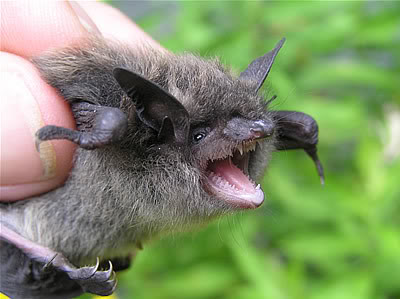 A few Sunday mornings ago, I woke up at 4 a.m. to find my husband standing in front of our bathroom door wearing rubber gloves and holding a plastic container with a magazine over the top. “There was a bat in the shower,” he told me. “I caught it.”
A few Sunday mornings ago, I woke up at 4 a.m. to find my husband standing in front of our bathroom door wearing rubber gloves and holding a plastic container with a magazine over the top. “There was a bat in the shower,” he told me. “I caught it.”
My initial thought was, “Yikes!” followed by “Ewwww.” But in my early-morning haze, I dozed off relegating the situation to a strange dream. Meanwhile, my animal-lover husband released the bat in the yard.
The next morning, I learned that the bat most likely entered our house through my one-year-old’s bedroom and was flying around in our bedroom before it settled in the shower. Gross, I thought, but not much more – until a friend mentioned she got the rabies vaccination after finding a bat in her house. The warning inspired me to conduct a quick Internet search. To my surprise, I found this: Springtime Means Rabies in New York State, which includes the following passage:
“Anyone who is bitten, scratched, or exposed to the saliva of an animal with rabies is at risk for contracting this fatal virus. While there is a very effective vaccine for rabies, it must be administered before any symptoms of the disease appear. Once human beings develop symptoms of rabies, they face certain death. Call the Health Department immediately for any contact with bats, even if a bat is found in the home without having definitely bitten someone. “
We called and, after a series of questions, a nurse determined our entire family would need the rabies vaccine series – four shots over a three-week period – immediately. I was skeptical. As far as we knew, the bat hadn’t touched any of us. And it was probably a healthy bat anyway…right? I sat down to do some further research.
Within minutes, I found the New York State Health Department’s Wadsworth Center, a science-based community focused on improving health through laboratory analysis, investigations and research. Perfect!
I learned that 22 people in the U.S. have been infected with rabies since 1990. Of those, 20 contracted the disease from bats. Only one of these cases involved a clearly documented bat bite. In the others, there was a bat encounter but no bite was detected. I also learned in the state of New York, 4 percent of bats encountered by people are found to be rabid.
The chance that we were actually exposed to rabies was still rather slim, but that wasn’t a risk I was willing to take considering the consequence was “certain death.” So, we headed to our local hospital for our first round of shots.
The good news is that the rabies vaccine is a very good insurance policy: no one has ever contracted rabies after getting the shots. Three cheers for medical research!
As for my family, we used our weekly doctor appointments as bonding time with a visit to the local ice cream parlor after each round. All thanks to a bat.
– Sheri Hall



“Three cheers for medical research” . . . and at least one for that knowledge-at-our-fingertips resource.
My mom likely would’ve flipped open Dr. Spock’s “Baby and Child Care” and/or called our pediatrician, who might have had little or no bat exposure experience.
This empowering progress, in one generation, is worth appreciating again:
“The warning inspired me to conduct a quick Internet search. . . . I sat down to do some further research.”
Thanks for the reminder and a vivid tale, Sheri. “Those words “certain death” do communicate clearly, indeed.